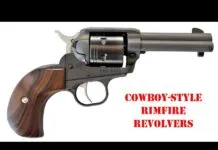Marlin Model 1894 Cowboy Our Pick Of .45 LC Cowboy Rifles
The S.A.S.S. eventually begat Cowboy Action Shooting, and the rest is history in the making. No other shooting sport is growing as fast. It got a foothold in California, moved into Arizona, then Texas, is presently spreading rapidly through Florida, Pennsylvania, Georgia and doubling the number of active participants nationwide every 12-1...
Remington Model 700 Police Tops Savage Model 110FP Tactical
Remember that daylight bank robbery in California a few months back? The bad guys were illegally armed to the teeth, wearing body armor and spraying lead in all directions. If there had been a movie crew around, one might have thought they were filming Lethal Weapon 4.
If you saw the TV news coverage, the image of one armored bandit being dropped in his tracks will probably stay with you a long time. That shot was taken with a rifle capable of MOA (minute of angle) accuracy at 100 yards. In the hands of law enforcement, they're called sniper rifles. The rest of us call them target or varmint rifles. Except for finish and perhaps some high tech, highly expensive add-on optics, they're muc...
Sako Model 75 Hunter Tops Steyr, Browning .308 Win. Rifles
We recently undertook to answer that question in a comparison three high-end bolt action rifles from Sako, Steyr and Browning, all of which list for over $900. Our test guns were the Sako Model 75 Hunter, the Steyr SBS Forester and the Browning A-Bolt II Eclipse.
Naturally, we were curious about how well this grade of rifle...
Browning BPR: A Winning Pump Action Rifle In .270
The bolt action rifle is easily the most popular type of centerfire hunting rifle in this country, and for good reasons. They are accurate, reliable and easy to use. The second most popular type of hunting arm is the lever action rifle. Such guns aren't accurate at long distances, but these easy-handling firearms are just what is needed in the brush where distances are short.
Excluding rimfire models, the least popular type of hunting firearm is the pump action rifle. This is probably because one of the main contact points between a rifle and a shooter or rest, the forend, isn't fixed and typically has some side-to-side play. If a gun isn't held steady, it is difficult to hit the intende...
Ruger M77RSP Mk II Edged Out Remington, Winchester .30-06s
Anyone seeking an all-around cartridge for North American hunting would be well served by the .30-06. In fact, the cartridge would be pretty handy just about anywhere one wanted to hunt, worldwide. Make the rifle out of stainless steel, put it in a synthetic stock, and you've got a versatile, durable tool that ought to last several lifetimes.
The .30-06 is the most popular cartridge all over the world, and rightly so. The many varieties of bullet weights, types and velocities available, in both factory loads and as components for the handloader, are unmatched in any other cartridge. There are saboted lightweight bullets at varmint-getting velocities, heavyweights up to 220 grains with eno...
Remington Model 700 BDL Edges Out Ruger, Savage .25-06 Rifles
It was Neidners intent to develop a varmint round that drove 80+ grain bullets at higher velocity and flatter trajectory than the .250-3000 Savage or .25 Krag, then widely used for Chucking. He achieved this by retaining the overall case length and shoulder angle of the .30-06 while necking it down to accept the smaller projectile. For a combination of reasons, not the least of which were the Great Depression, World War II, and the ex...
Ruger 77/22 VMBZ Our Pick In .22 Magnum Varmint Rifles
About 50 or 60 years ago, every boy had a .22 rifle, knew how to shoot it and had a place to shoot it. We are quite sure that each and every one of those boys longed for a bit more power from their rimfires. They figured they'd be happy if the darned bullet shot just a tiny bit flatter and hit with a bit more power. Unfortunately, the .22 Winchester Rimfire (WRF) was in the process of becoming obsolete, and anyone who bought one of those rifles seeking just a bit more power was doomed to run out of ammunition. However, its replacement was already on the drawing boards.
The .22 Winchester Magnum Rimfire (WMR) came into being in 1959. The first guns available were actually Ruger and Smith &...
Marlin Model 30 AW Our Pick In A .30-30 Lever-Action Rifle
Deer rifle. Cowboy gun. Saddle carbine. The .30-30 lever-action rifle is well known, no matter what you call it. Whether you want a knock-about rifle for hanging in the back window of your pickup, slinging under your foot on a snowmobile, or to use for the serious work of knocking down your yearly supply of venison, the .30-caliber lever rifle is one handy tool.
Where does it shine? Actually, the lever-action rifle doesn't really shine for much of anything, truth be told. Normally, today's lever rifle isn't known as a tack driver, but there are exceptions. Neither is the .30-30 an overwhelming powerhouse. Lever rifles tend to be reliable and, above all, handy. They're slimmer by far than...
The Browning BAR Lightweight is Superior to Remington 7400 Carbine
In spite of what some people may say or think, we feel a semiautomatic rifle is a worthwhile hunting arm. A bolt-action rifle may work just fine for most hunters, but manually-operated firearms are extremely difficult, if not impossible, for physically disadvantaged people to use. Also, a semiautomatic rifle's ability to deliver a fast follow-up shot can prevent wounded game animals from suffering needlessly.
There is, of course, a downside to the semiautomatic rifle. It typically weighs about 1/2-pound more than most bolt-action sporters, making the gun tiresome to carry around for any length of time. However, the .30-06 Springfield rifles in this test solve the weight problem. They are...
Marlin Model 7000 Our Pick In A Heavy-Barrel .22 Semiauto Rifle
Autoloading .22's are lots of fun and can be lots of gun. They tend to run you broke on ammunition because of the lure of easily and quickly firing off the entire magazine. In fact, this might be one reason to own a semiauto .22 that has a limited number of rounds in the magazine, say five to seven rounds. This limitation tends to force the shooter to make every shot count, much as the fellow with a six-shot muzzle-loading revolver is reluctant to shoot quickly because of all the work needed to make the gun ready to go again.
Be that as it may, self-loading .22's offer lots of shooting fun, but unfortunately many of them are not all that accurate. They would be more fun if they could hit...
New Steyr Scout Rifle! An Interesting .308 Performer
After many years of soaking in the think tank, the Scout Rifle is here. If you know nothing about Jeff Cooper and his Scout Rifle, it means you probably haven't read anything he has written in the last few years. When two gun enthusiasts get together, sooner or later the age-old question will pop up, "If you could have only one firearm, which one would it be?" Jeff Cooper has taken his answer to the next level by developing what he thinks is the only rifle you will ever need.
So, what is a Scout Rifle? In Mr. Cooper's own words, "its a general-purpose weapon suitable for any use to which a rifle may be put, with the exception of the pachyderms and the buffalo." The rifle's manufacturer,...
Winchester 70 CS BOSS Our Pick In A Braked 7mm Magnum
Those who already have a .270, .280, .308, .30-06, or about half a dozen others of that ilk, and want to buy a 7mm Magnum to get a hotter, flatter-shooting rifle are simply paying good money to essentially duplicate what theyve already got. In actual fact, theres not a great deal of performance difference between any of those above calibers and the 7mm Remington Magnum. Take your pick, and within reasonable game-shooting distances any one will do as well as any other one, with r...































